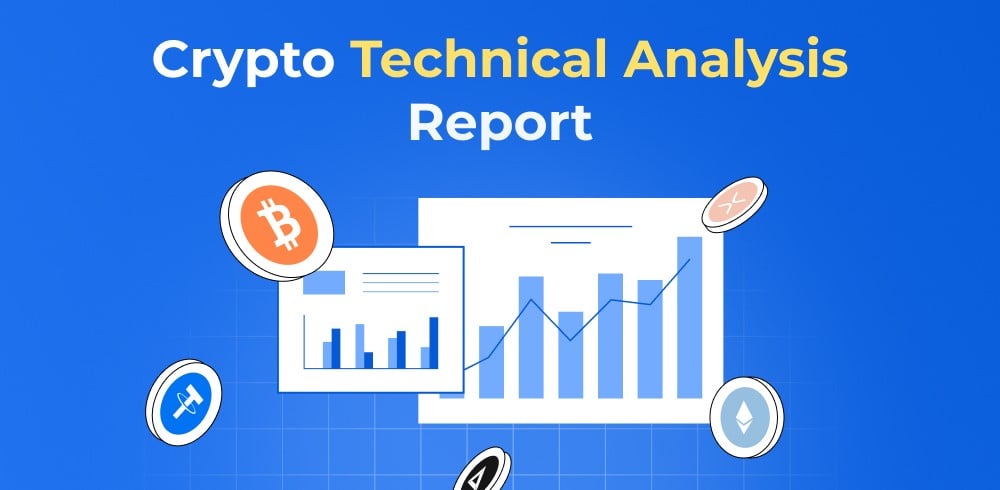The fib retracement tool is a widely used method in crypto trading, based on the mathematical ratios of the Fibonacci sequence. It plots horizontal percentage lines on a chart to serve as potential support and resistance levels, helping traders identify trend reversals and key price points.
A retracement shows how much of a previous price movement has been pulled back. These levels are calculated from the preceding trend, with commonly used percentages being 23.6%, 38.2%, 50%, 61.8%, and 78.6%. Traders can apply the fib retracement tool between any two significant price points, such as a swing high and swing low, to anticipate market reactions. This guide will explain how the tool works, its advantages and limitations, and how to calculate and use fib retracement levels effectively in crypto trading.
What Is the Fibonacci Sequence?
The Fibonacci sequence is a famous number pattern in mathematics where each number is created by adding the two numbers before it. It begins with 0 and 1, and continues as 1, 2, 3, 5, 8, 13, 21, 34, and so on. While this sequence may seem purely theoretical at first, it appears widely in nature, art, architecture, and financial markets.
In trading, especially when using tools like fib retracement, this sequence becomes highly practical. Specific ratios derived from the Fibonacci sequence—such as 23.6%, 38.2%, 50%, 61.8%, and 78.6%—are used to analyze price movements and potential reversals. These percentages help traders understand how much of a previous price move might retrace before continuing its trend.
Because of its consistent mathematical structure and real-world relevance, the Fibonacci sequence forms the foundation of many technical analysis tools, with fib retracement being one of the most widely used in crypto trading today.
How Does Fibonacci Retracement Work?
In crypto trading, the fib retracement tool is an essential way to identify potential support and resistance levels. To use it, connect the asset’s highest point to its lowest with a line. This sets up Fibonacci levels derived from the famous sequence: 0, 1, 1, 2, 3, 5, 8, 13, and so on, where each number is the sum of the previous two. From this sequence, traders focus on key ratios: 23.6%, 38.2%, 50%, 61.8%, and 78.6%, marking horizontal lines on the chart at each level.
For example, if a crypto rises from $30 to $36—a $6 increase—draw a line between these points. Then place horizontal lines at each fib retracement level. The 23.6% level is 23.6% of $6 below $36, calculated as $6 × 0.236 = $1.416, so $36 − $1.416 = $34.58 marks the 23.6% retracement. Repeat the calculation for 38.2%, 50%, 61.8%, and 78.6% to find all corresponding levels from the peak.
What Are Fibonacci Levels?
Fibonacci levels are key price points derived from the Fibonacci sequence and its associated ratios. In trading, these levels are used to highlight potential support and resistance zones where the price may pause, reverse, or continue its trend. Traders rely on these levels to better understand market behavior and plan entries, exits, and risk management strategies.
When applied using the fib retracement tool, Fibonacci levels are drawn between two significant price points—usually a recent high and low. The tool automatically plots percentage-based horizontal lines across the chart, giving traders a visual framework to analyze how far a price might pull back before resuming its original direction.
Key Fibonacci Ratios Explained (23.6%, 38.2%, 50%, 61.8%, 78.6%)
Each Fibonacci ratio represents a specific depth of price retracement and serves a different role in market analysis:
- 23.6% – A shallow retracement that usually appears in strong trends. Price often makes only a brief pullback at this level before continuing in the same direction.
- 38.2% – A common correction level where price frequently pauses or consolidates before deciding its next move. It indicates a healthy pullback within an ongoing trend.
- 50% – Not a true Fibonacci ratio, but widely used by traders as a psychological midpoint. A retracement to this level suggests that half of the prior move has been corrected.
- 61.8% – Known as the Golden Ratio level, this is the most closely watched fib retracement zone. Strong price reactions, reversals, and trend continuations often occur here.
- 78.6% – A deep retracement level that tests the strength of the prevailing trend. If price holds above or below this level, it often signals a potential trend continuation rather than a full reversal.
Together, these Fibonacci levels help traders estimate where price reactions are most likely to occur, especially when combined with the fib retracement tool and other technical indicators.
How Do I Calculate Fibonacci Retracement levels?
We don’t have a set way to work out Fibonacci levels. These are the ratios of a price range. The levels come from a sequence where each number is around 1.618 times bigger than the last. This ratio is called the “golden ratio.” It’s named this since the sequence’s roots are math-based and the ratio appears often in nature. To find Fibonacci levels for a crypto coin’s price, traders use this method:
- For an uptrend retracement: High Swing – [(High Swing – Low Swing) × Fibonacci Percentage]
- For a downtrend retracement: Low Swing + [(High Swing – Low Swing) × Fibonacci Percentage]
Understanding the Golden Ratio in Trading
The Golden Ratio, commonly represented as 1.618 or its inverse 0.618, is one of the most powerful concepts derived from the Fibonacci sequence. In trading, this ratio plays a crucial role in identifying potential price reversals, trend continuations, and key decision-making zones. It is especially significant in technical analysis because markets often react around levels linked to this ratio.
When using the fib retracement tool, the 61.8% level is considered the most important retracement zone and is directly tied to the Golden Ratio. Traders closely watch this level because prices frequently bounce or reverse from it, making it a strong area for potential entries, exits, or stop-loss placement. The related extensions, such as 161.8%, are also used to project future price targets.
In crypto trading, where price movements are fast and often volatile, the Golden Ratio helps bring structure to market analysis. By combining it with fib retracement levels and other indicators, traders can better identify high-probability setups and manage risk more effectively.
How Do I Use Fibonacci Retracement in Crypto?
Crypto markets experience rapid price shifts, so traders need ways to identify when trends could reverse. Fibonacci retracement levels aid in locating potential support and resistance zones. First, find the uptrend or downtrend’s peak and trough prices. For an uptrend, use the lowest low and highest high prices. For a downtrend, use the highest and lowest prices. Then, plot lines at 23.6%, 38.2%, 50%, and 61.8% between those extreme prices marked potential reversal points.
Each Fibonacci level could signal a price reversal if it is reached. If the price moves beyond a certain level, the trend may continue toward the next ratio. To find support levels, start with the lowest (swing low) to the highest (swing high) points. Resistance levels use the highest (swing high) and lowest (swing low) points as the first and second reference values. Prices often pause or reverse at these Fibonacci ratios within a larger trend.
Benefits and Risks of Fibonacci Retracement
There are advantages and disadvantages to using Fibonacci retracement levels in crypto trading:
Advantages
- Identifies Key Levels: Fibonacci retracement helps traders pinpoint potential support and resistance levels for a stock. Breaching these levels can signal optimal buy or sell points.
- Easy to Use: Traders find this method easy to grasp. It follows a simple process that one can repeat over time.
- Objective: Making decisions without emotions is crucial. Fibonacci ratios give objective guidance, helping avoid unnecessary losses.
Disadvantages
- Potential Inaccuracies: Inaccuracies occur if traders depend solely upon Fibonacci retracements to pinpoint support or resistance. This increases trading risks.
- Historical Data Reliance: Previous data forms Fibonacci retracement’s basis. Yet, history may fail to accurately predict upcoming price movements, like other technical analysis tools.
- Overused Tool: Many traders overuse this tool, diminishing its predictive effectiveness.
- Market Volatility Impact: Market volatility impacts Fibonacci retracement’s reliability. Previous support and resistance are invalidated when volatility fluctuates prices significantly.
When Should Traders Use Fibonacci Retracement?
Traders typically apply the fib retracement tool after a strong price move, once the market begins to pull back. It is most effective in clearly trending markets, where price corrections offer opportunities to enter at better levels instead of chasing momentum. By drawing fib retracement between a recent high and low, traders can identify potential support and resistance zones where the price may stabilize, reverse, or resume its original trend.
In crypto trading, where volatility is high, fib retracement is often combined with other indicators such as moving averages, volume, and trendlines for confirmation. It helps traders plan entries, set stop-losses, and define risk more precisely during corrective phases. When used correctly, fib retracement adds structure to price action and improves decision-making during both bullish and bearish market conditions.
Identifying Trend Continuation vs Reversal
- Reaction at fib retracement levels – If price respects key fib retracement zones like 38.2%, 50%, or 61.8% and bounces in the direction of the original trend, it signals trend continuation. A clean break below or above these levels may hint at a possible reversal.
- Volume behavior during pullbacks – Low trading volume during a retracement followed by rising volume on the trend’s return often confirms continuation. Heavy volume against the trend can be an early warning of reversal.
- Candle structure near key levels – Strong rejection candles, long wicks, or bullish/bearish engulfing patterns at fib retracement levels support continuation. Weak or indecisive candles may suggest trend exhaustion.
- Market structure and price swings – Higher highs and higher lows in an uptrend (or lower highs and lower lows in a downtrend) near fib retracement zones indicate continuation. A break in this structure points toward reversal.
- Indicator confirmation – When indicators like RSI, MACD, or moving averages align with signals at fib retracement levels, the probability of continuation increases. Divergences near these zones often signal a potential reversal.
Common Mistakes When Using Fibonacci Retracement
- Using fib retracement in sideways markets – One of the most common mistakes is applying fib retracement when the market has no clear trend. The tool works best in trending conditions, and using it in choppy or range-bound markets often leads to false signals.
- Drawing levels from the wrong price points – Incorrectly selecting swing highs and lows can distort fib retracement levels. Traders should always draw from clear, significant price extremes rather than minor fluctuations to get accurate support and resistance zones.
- Relying only on fib retracement for decisions – Depending solely on fib retracement without using other indicators like volume, RSI, or moving averages increases the risk of poor trade entries. The tool should be used as part of a broader trading strategy.
- Ignoring market context and trend strength – Fib retracement levels are more reliable in strong trends. Using them without considering overall market structure, news events, or momentum can result in misreading price reactions.
- Forcing trades at every Fibonacci level – Not every fib retracement level will produce a valid setup. Jumping into trades at every level without confirmation often leads to unnecessary losses and overtrading.
Conclusion
Using fib retracement as part of your crypto trading toolkit can provide a strong advantage by clearly highlighting potential support and resistance zones. These levels help traders time entries and exits more effectively while managing risk with greater precision. However, relying solely on fib retracement is not recommended. For more consistent results, it should be combined with other technical indicators, chart patterns, and market trends to build a well-rounded and reliable crypto trading approach.
In the grand scheme of things, ZebPay blogs are here to provide you with crypto wisdom. Get started today and join 6 million+ registered users to explore endless features on ZebPay!






